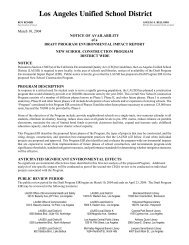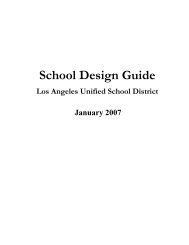Site-Specific Health and Safety Plan (HASP) - Laschools.org
Site-Specific Health and Safety Plan (HASP) - Laschools.org
Site-Specific Health and Safety Plan (HASP) - Laschools.org
You also want an ePaper? Increase the reach of your titles
YUMPU automatically turns print PDFs into web optimized ePapers that Google loves.
Table 6-2<br />
Practical Quantitation Limits<br />
Los Angeles Unified School District Proposed South Region Highschool #9 <strong>and</strong> Middle School #4<br />
Method/Analyte a/<br />
PQL c/<br />
Water b/<br />
MCL (Fed.) d/ MCL (CA) e/<br />
PRG f/<br />
Soil<br />
PQL PRG g/<br />
Lead 0.003 NA NA NA 0.3 400<br />
Manganese 0.015 NA 0.05 m/ 0.88 1.5 1800<br />
Molybdenum 0.02 NA NA 0.18 2 390<br />
Nickel 0.05 NA 0.1 0.73 5 1600<br />
Selenium 0.005 0.05 0.05 0.18 0.5 390<br />
Silver 0.01 NA 0.1 m/ 0.18 1 390<br />
Thallium 0.001 0.002 0.002 0.0026 1 5.5<br />
Vanadium 0.05 NA 0.015 l/ 0.26 5 550<br />
Zinc 0.02 NA 0.5 m/ 11 5 2.30E+04<br />
Hexavalent Chromium (SW7199A) (ug/L) (ug/L) (ug/L) (ug/L) (ug/kg) (ug/kg)<br />
Hexavalent Chromium 0.3 w/ NA NA 0.16 40 200<br />
Cold Vapor Atomic Absorption (mg/L) (mg/L) (mg/L) (mg/L) (mg/kg) (mg/kg)<br />
Mercury (SW7470A/7471A) 0.0005 0.002 0.002 0.011 0.25 23<br />
Anions (SW9056) (mg/L) (mg/L) (mg/L) (mg/L) (mg/kg) (mg/kg)<br />
Chloride 1 NA 250 t/ NA 1 NA<br />
Nitrate 1 10 45 NA 1 NA<br />
Sulfate 1 NA 250 t/ NA 1 NA<br />
Methane, Ethane, Ethene (RSK-175SOP) (mg/L) (mg/L) (mg/L) (mg/L) (mg/kg) (mg/kg)<br />
Methane 0.05 NA NA NA NA NA<br />
Ethane 0.05 NA NA NA NA NA<br />
Ethene 0.01 NA NA NA NA NA<br />
Total Organic Carbon (SW9060) 1 NA NA NA 100 NA<br />
a/ Methods: SW - U.S. Environmental Protection Agency (EPA). 1995b. Test Methods for Evaluating Solid Waste:<br />
Physical/Chemical Methods, SW-846, (3rd Edition, including Updates I, II, III <strong>and</strong> IIIA). USEPA Methods for the Analysis of Water <strong>and</strong> Wastes (1993)<br />
b/ Water PQLs should meet tap water PRGs as the project threshold value. When PQLs cannot detect down to tap water PRGs, California MCLs (when available) will be used as<br />
the project threshold value. If California MCLs are not available, then federal MCLs become the project threshold.<br />
c/ PQL = Practical Quantiation Limit<br />
d/ MCL (Fed) = Federal Maximum Contaminant Level for drinking water<br />
e/ MCL (CA) = Primary California Maximum Contaminat Level for drinking water (Title 22 CCR)<br />
f/ PRG = Preliminary Remediation Goal for Tap Water (EPA Region 9) (USEPA, 2002)<br />
g/ PRG = Preliminary Remediation Goal for Residential Soil (EPA Region 9) (USEPA, 2002)<br />
h/ µg/L = microgram per Liter<br />
i/ µg/kg = microgram per kilogram<br />
j/ PQL is greater than the tap water PRG but less than MCL. Project DQOs met since MCL is regulatory threshold for potentially triggering further action.<br />
k/ This PQL although above the PRG represents the lowest possible detection limit for this compound <strong>and</strong> will be used as the project threshold value.<br />
Table6-2rev4.xls<br />
Page 7 of 8<br />
5/7/2008<br />
311







